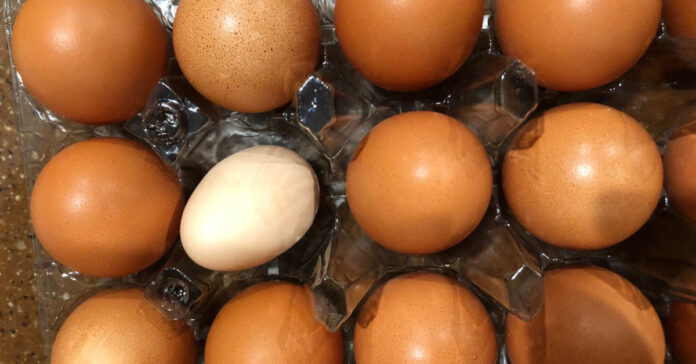Our chickens set a record, laying six eggs per day, more than we can eat. We gave away our third dozen and are planning to give eggs to two other friends in the next week.
Considering that temperatures are falling and the days are getting shorter, the increased quantity of eggs is good news. It also means that when next spring rolls around, we should get close to 12 eggs per day as production usually rises in the spring and summer months.
One egg was tiny and a lighter color. I can only assume it was the first egg ever from one of the Speckled Sussex hens, which are supposed to reach maturity two weeks later than our Red Star hens.
I have purchased two clear acrylic sheets to place over the screened windows. This will allow the sunlight to get into the coop while minimizing the wind and cold air. I am trying to determine the best way to attach these to the coop. I am leaning toward using bolts with large washers. This needs to be done before the cold weather and possible snow predicted to hit much of the country arrives next week.
Every time I go into the chicken run, which is at least once per day and often two or more times, the chickens crowd my feet and occasionally pack at my feet and legs. Makes me glad for by big muck boots.
Beehive Winterization
I also purchased a roll of tar paper to use in winterizing the beehives. While there are probably as many ways to winterize hives as there are bee keepers, I selected this method because it accomplishes two things: First, it provides a wind-proof barrier. Second, it gets hot in the sunlight and conveys the heat to the hive itself. I felt this would have advantages over fiberglass insulation, which keeps the cold out but also blocks the warming rays of the sun.
While we get plenty of wind and snow, we also get bright sunshine, especially in the morning and early afternoon. When this sun hits the black tar paper, it will heat the hives, making it easier for the bees to keep themselves, the queen and any brood warm.
I am also going to be adding a couple of sheets of Reflectix to the inside of the hive covers, hopefully reflecting any heat back to the bees instead of escaping out the top.
Finally, I need to check the level of each hive. Because the hot interior and the cold exterior create condensation in the hive, I want to tilt the hives forward ever-so-slightly so any water that runs down the walls and accumulates on the bottom will run out. The last thing we want is ice to form in there.
I hope to have both the chicken coop and the beehive winterization complete by this weekend.
Shopping Trip
I made an excursion to Lowes and harbor Freight this past weekend to lay in the necessary supplies. Harbor Freight was running some good sales, and I picked up a heavy duty nine mil 9’ x 11’ tarp for $9.75 using one of their coupons. Do I need a tarp? No, but I consider them one of those useful items that are good to have on hand. Most of my tarps are covering stacks of firewood, and this is the perfect size to drape over a stacked cord.
From what I observed, there were plenty of goods at both Harbor Freight and Lowes and no obviously empty shelves. I found everything on my shopping list.
Tips on Tarps
One thing I learned during our move is that cheap tarps are a waste of money. Both the tarps we used to cover furniture and other items on a flatbed trailer during our move got torn to shreds. Everywhere there was a combination of the tarp rubbing the edge of something and high wind from the highway speeds, the tarp wore through. One blue tarp was a mass of blue and white strands, a total loss. We salvaged a very large brown tarp, my cutting out the bad section and leaving two pieces. The remaining pieces covered up my firewood last year, but were in such bad condition by this spring that I just tossed them.
Since then, I’ve been buying tarps of at least 8 mils thick. I’ve sworn off the 4 and 5 mil tarps and recommend you do as well, unless you need one for a single use. At Harbor Freight, the price difference between the five mil 9’ x 11’ tarp and the nine mil tarp I purchased was $1. That seems like a no brainer, even if you don’t like the color.
I think every prepper should have a few tarps on hand. You can use them for things like covering holes when a tree falls on your house and punctures the roof or high winds rip off shingles. You can also use them as an improvised shelter in the field, to cover and protect equipment, or to waterproof an underground bunker.







